May 17th 2023, San Francisco.
San Francisco is ridiculously beautiful.
At every turn, up every hill, across every vista by the bay, the city is just stunning. And it is not a strained, forced beauty. It is not beating you over the head like, say, Hollywood — ‘look at me, look at me’ — and yet you can’t take your eyes off it. There’s little that’s vulgar about San Francisco but there’s much that’s cool and classy, and an awful lot that makes one stop, and linger to admire It’s also laid back. The city sort of jogs along doing its thing. The pretty bits are not so precious that they have a don’t-you-dare-touch me feel to them. And if you don’t like this bit, there’ll be another bit around the corner that you’ll love.
I had only few days in the place but I’m spinning. It’s not as though I saw absolutely everything one must see as a visitor. In fact, I barely scratched the surface but I still had the feeling, very strongly, that if I was in my 20s, this is a city that would pull me towards it like a high-charged magnet and I would relish not resisting. I entered along Highway 101 and, as luck would have it, my hostel-cum-hotel, the Samesun, was on Lombard Street, which 101 becomes as it morphs into Van Nees and then hurtles on over the Golden Gate Bridge, which is only a few miles away. Next morning, I went walkabout up Lombard and found myself at Sterling Park, an unkempt square abutting Hyde Street. A plaque at the entrance explained that it was dedicated to the poet George Sterling (1869-1926), of whom I had not heard but who was pally with a writer I like, Jack London. Sterling became the unofficial poet laureate of the city through his romantic verse and a sample of it on a bronze plate at the park stayed with me as I explored over the following days.
Tho the dark be cold and blind,
Yet her sea fog’s touch is kind,
And her mightier caress
Is joy and the pain thereof;
And great is thy tenderness
O cool, grey city of love!
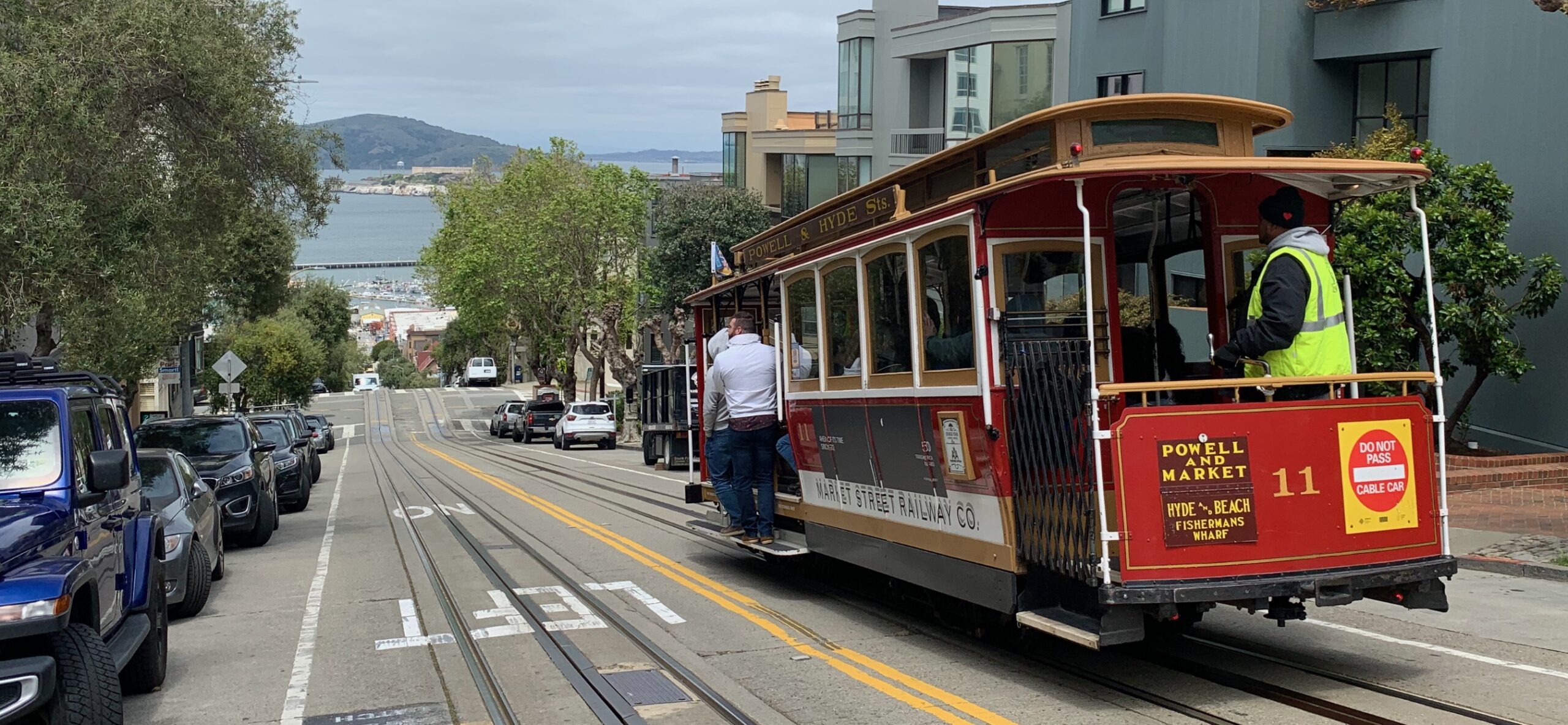
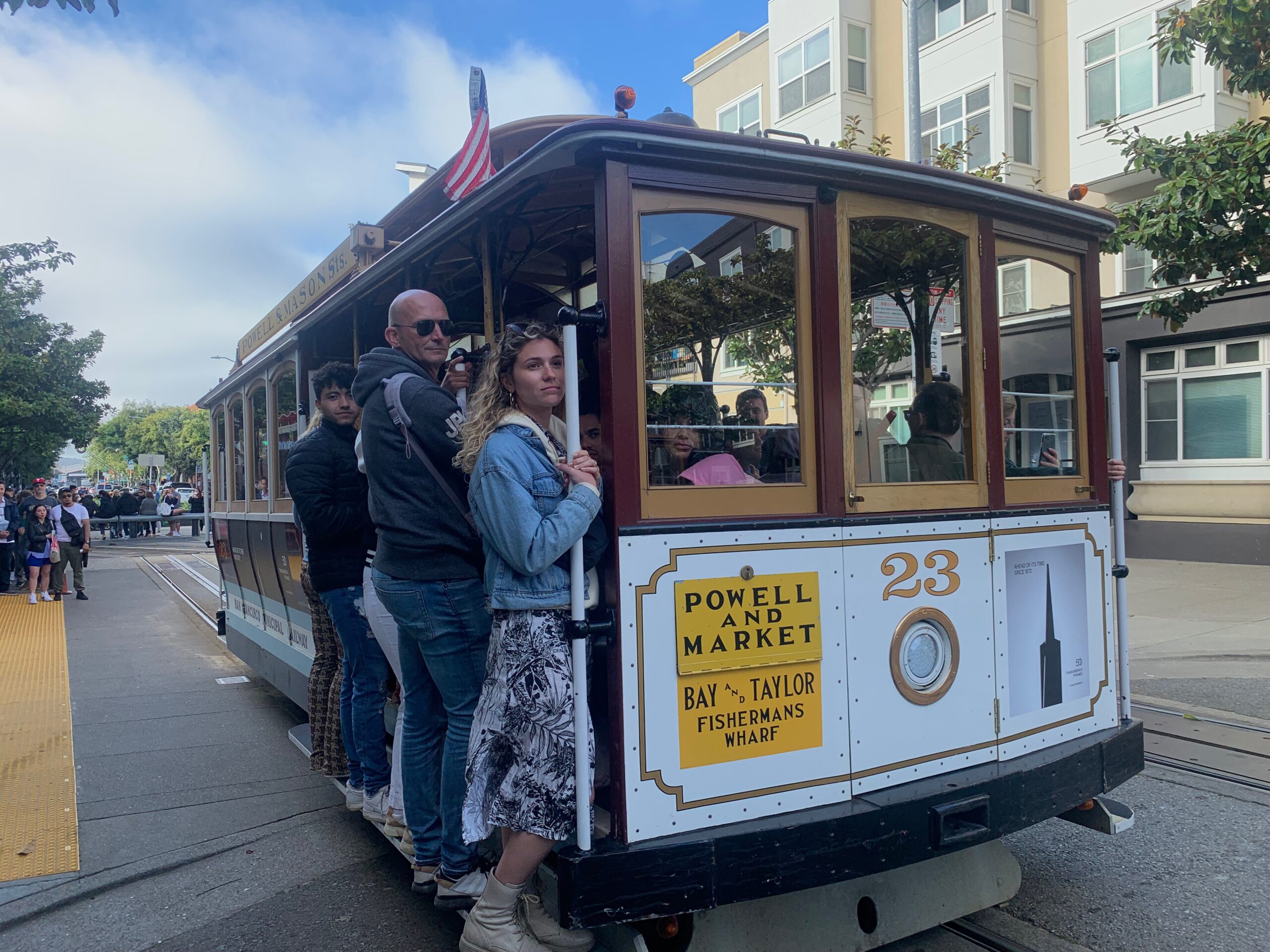
… Cool grey city… As I read the line, a cable car trundled along Hyde, sounding its bells, passengers standing on the running board, hanging on as the little wooden wonder slipped down towards Fisherman’s Wharf and I tried (and failed) to get a decent shot with Alcatraz Island in the background. But the scene — the cable car, the instantly familiar-looking street and, of course, the vista out onto the bay — suddenly had me thinking “Wow! I am in San. Fran. Sicso!” I jumped on a car heading in the opposite direction and soon found myself in Union Square which is the end of the Powell-Mason and Powell-Hyde lines (there’s one other, the California St line). At Union Square, there’s a turntable and they spin the little cars around and send them on their way back to the wharf.
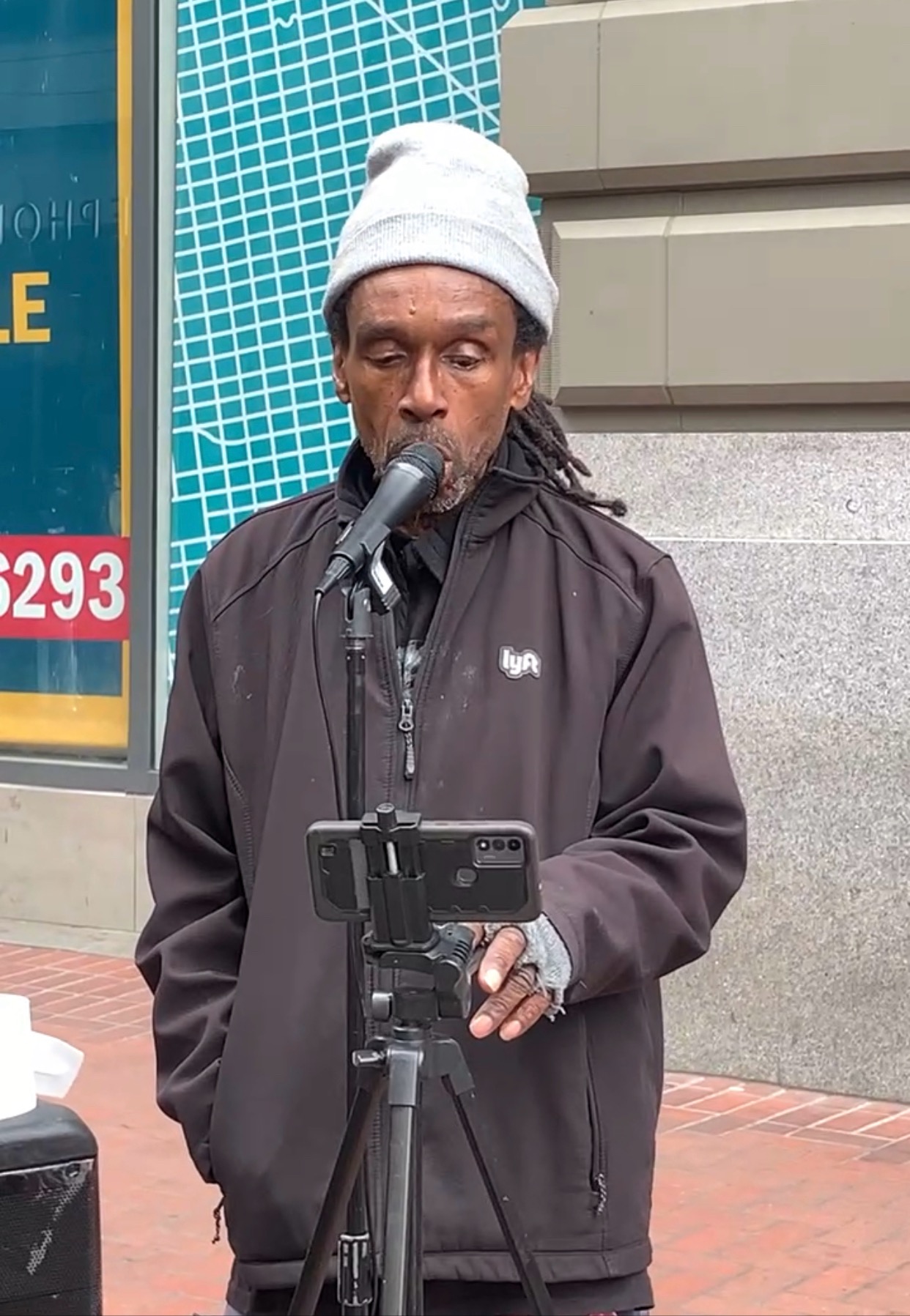
I didn’t return immediately though because there was a fantastic busker, a black guy singing for the cable car queue. Even though it was sunny, he looked cold and wore a beany, a zipped up black anorak and floppy, pyjama-like trousers, but he also had on like-new white trainers. He wore raggedy knitted fingerless gloves and there was something fragile about him, not helped by some missing teeth and a general demeanour, that suggested vagrant or shelter-dweller — though he may have been neither. Despite this, he had some trappings of modernity — a mobile phone mounted on a tripod which was linked to Spotify, or some other playlist, and a speaker that allowed him to, in effect, perform karaoke. But here’s the thing: despite his dishevelled appearance, he had a terrific voice and rattled off a string of foot tapping Motown numbers almost as good as the originals. Between him and the cable car queue, there was an open bag on the sidewalk and I can tell you it was bulging with dollar bills. I never got his name but he got some of my money, and deservedly so.
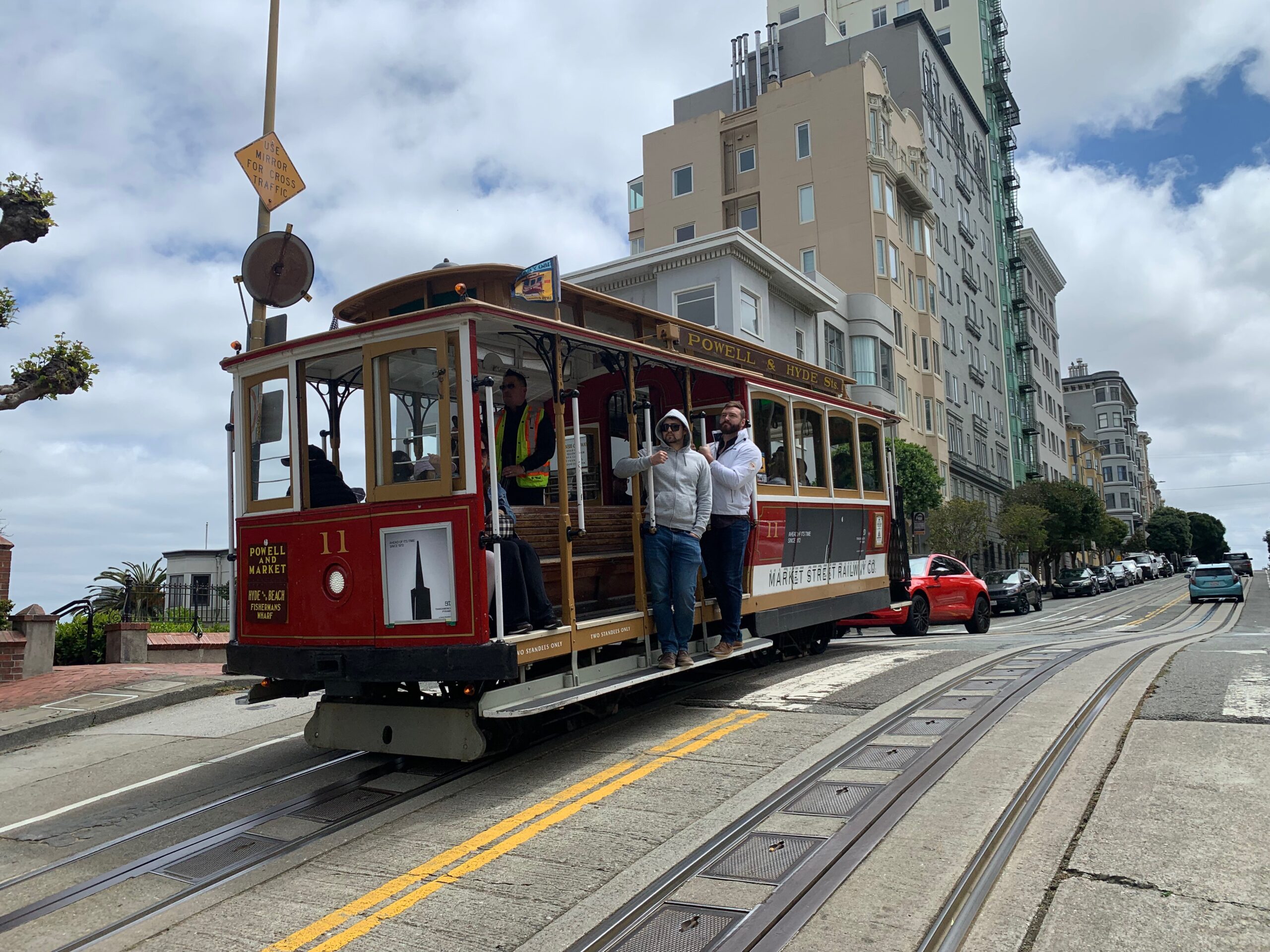
I took the tram back to the wharf side. The cars run singly but there’s one along every few minutes or so. The guys who operate them should be on a bonus from the city’s tourism promoters. They have that quintessentially American way of talking firm but friendly. To someone maybe blocking the hop on, hop off entrance, they’ll say “Sir! Step back into the carriage.” Or to someone standing on the running board and leaning out a bit too far to get a good shot of an oncoming car, there’ll be a “On the left side! Mind the oncoming car! Don’t wanna lose no passengers here, Ma’am.” They’re not really scolding you but at the same time, you know they mean business.
Each car has too people operating it — the grip operator, known simply as the grip, and the conductor, who collects fares and jumps off and back on again at stops, making sure passengers alight or join the car safely.
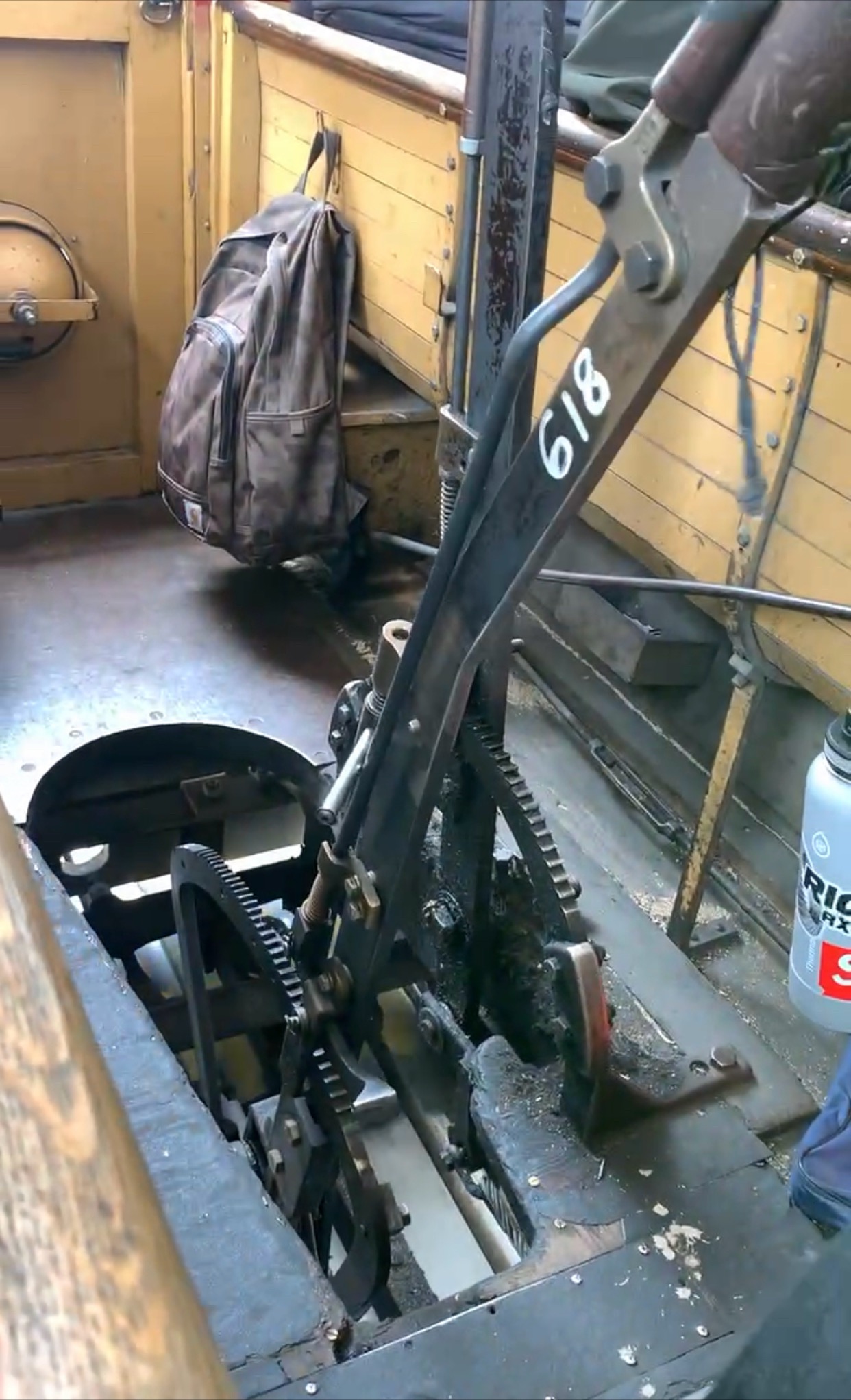
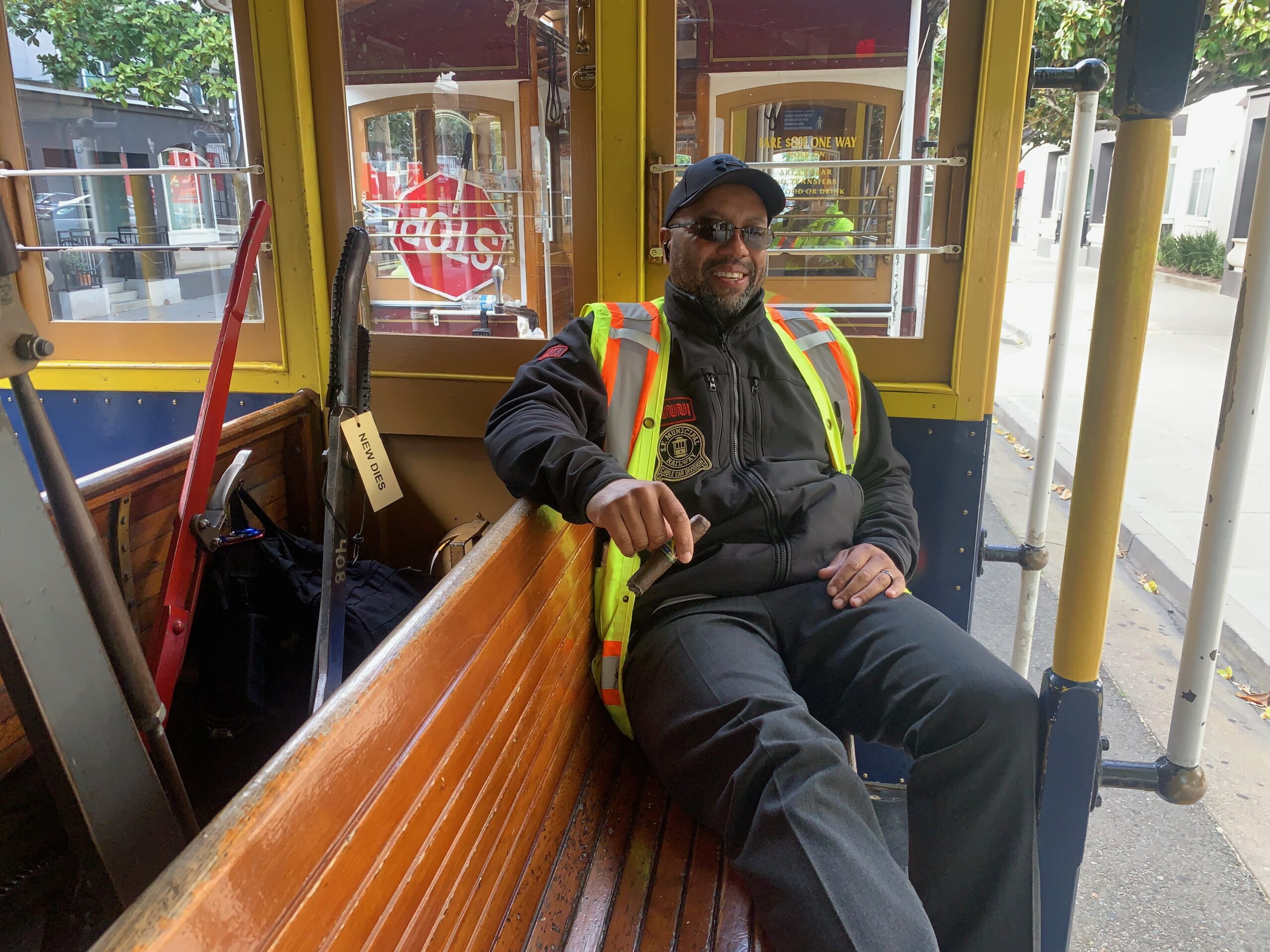
The mechanism and driving controls are totally Heath Robinson. Beneath the street, a moving cable runs below a slit in the surface. This is the cable that hauls the car up and down those San Francisco hills — “halfway to the stars”, as the song has it. Inside the car, sandwiched between two sets of bench seats, each facing sideways out as opposed to forward, are two levers and a foot break which are all operated by “the grip” — the driver who stay standing up throughout the journey. He also operates the car’s main bell (the conductor has one too but it seems to be used just to tell the grip that it’s safe to move off from a stop). The main bell is much the loudest and is used to warn traffic up ahead that a cable car is acomin’ their way. The levers are vertical and have a hand-release at the top, a bit like a bicycle break, allows the grip to control them back and forth, stopping them in the teeth of the sprocket, according to his judgement. One lever grabs hold, or loosens its grasp, of the moving cable beneath the tracks. When there’s no tram running along Hyde or Powell, or any of the other cable car streets, you can hear the hum and rattle of the cable as it moves along under the road. It’s one of the sounds of San Francisco. The other lever relates, I think, to stopping — quite important on those incredibly steep hills. But the foot pedal does that too. I think. I’m not 100 per cent on all this except that it looks mightily complex and the grip plays all three mechanisms simultaneously. One is never entirely sure what he’s at but it works and he and the conductor manage to mix serious attention to the detail of their work with playful banter. An alighting passenger may well be greeted by the conductor with a “Yo Ma’am! You didn’t bring one for me?”
One evening while walking to meet a new pal in a bar, I spied a grip or conductor lounging in a stationery cable car at the Taylor St terminus. He had a huge fat cigar and I asked him how many he smoked a day. “Oh this’ll do me for at least two days,” he said, explaining he only smoked it a bit at a time. I asked could I take his photo. “Sure,” he said, “you go right ahead.” He looked the essence of cool!
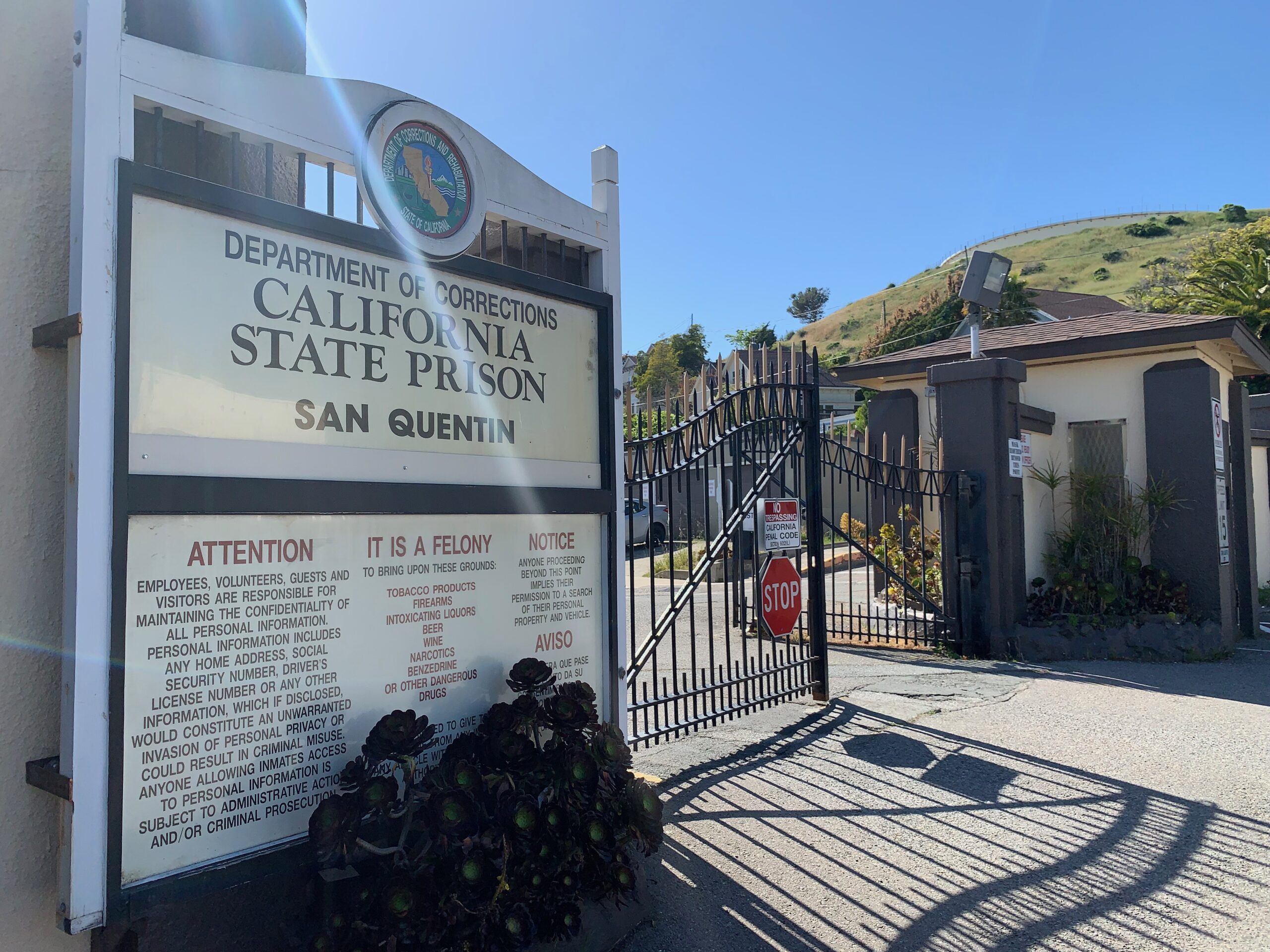
I went on a bike ride — around the city, including Chinatown (a bit scruffy but older and more real than others, such as London or Manchester’s, that I’ve been to) and over the Bay Bridge to Berkeley, returning via the Golden Gate. I didn’t stay long in Berkeley, just long enough to have some iced tea and a small mountain of delicious brisket on one of those food halls with multiple outlets. The way back around was over the Richmond Bridge which gave me the willies. It is very, very long — 8.5 kilometers — and high — 56 meters — and on a bike, you feel quite exposed. It is sort of freaky, the way in places you can also see right down to the water.
On the other side, almost immediately I see a sign that must be obeyed. San Quentin, it says. I hadn’t realised that the famous prison, or infamous depending on how you see these things, was here. But there it is — on a promontory in the bay just north of Sausilito. It is quite a complex, though you can’t see much from the entrance gate, which is at the end of a cul-de-sac of a few typically cute clapboard houses.
“Four thousand,” says Officer Mahmood manning the gate when I ask him how many inmates there are. “Used to be 6,000,” he adds.
I can’t go in, unfortunately, not even to ride up to the faux gothic, castellated building I can see at the end of the long driveway, an administration block maybe? There are several long buildings, three maybe four stories tall, that suggest long corridors with cells off them but it’s not really possible to see the place, and hence describe it properly, from the entrance. It’s kind of enough just to be there . . . with all its history: Johnny Cash’s 1969 concert and album — “San Quentin I hate every inch of you. . .” he drawled and the inmates hooped and hollered and cheered and clapped; its death row (the only one in California), gas chamber and lethal injection table (no executions since 2006).
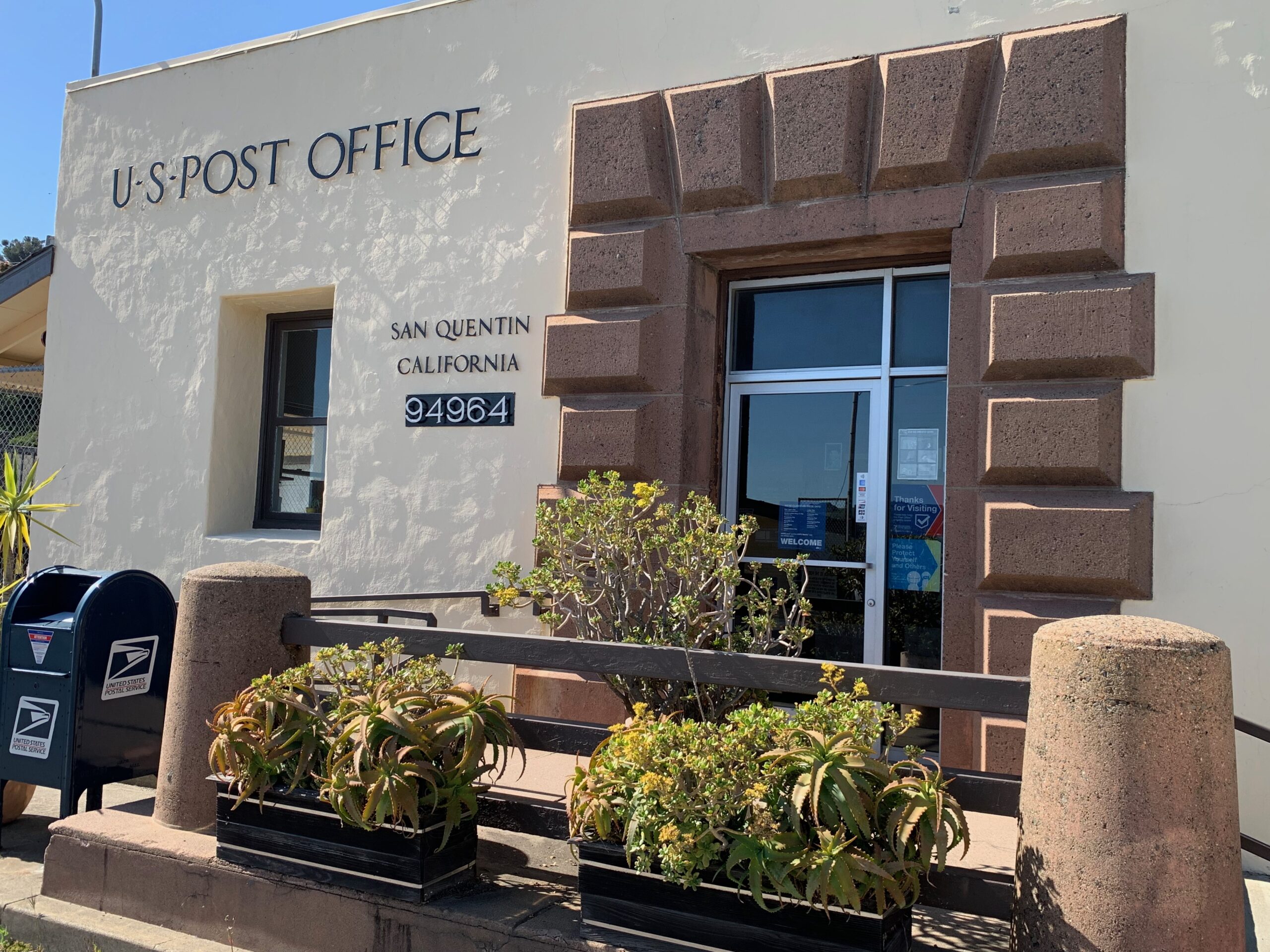
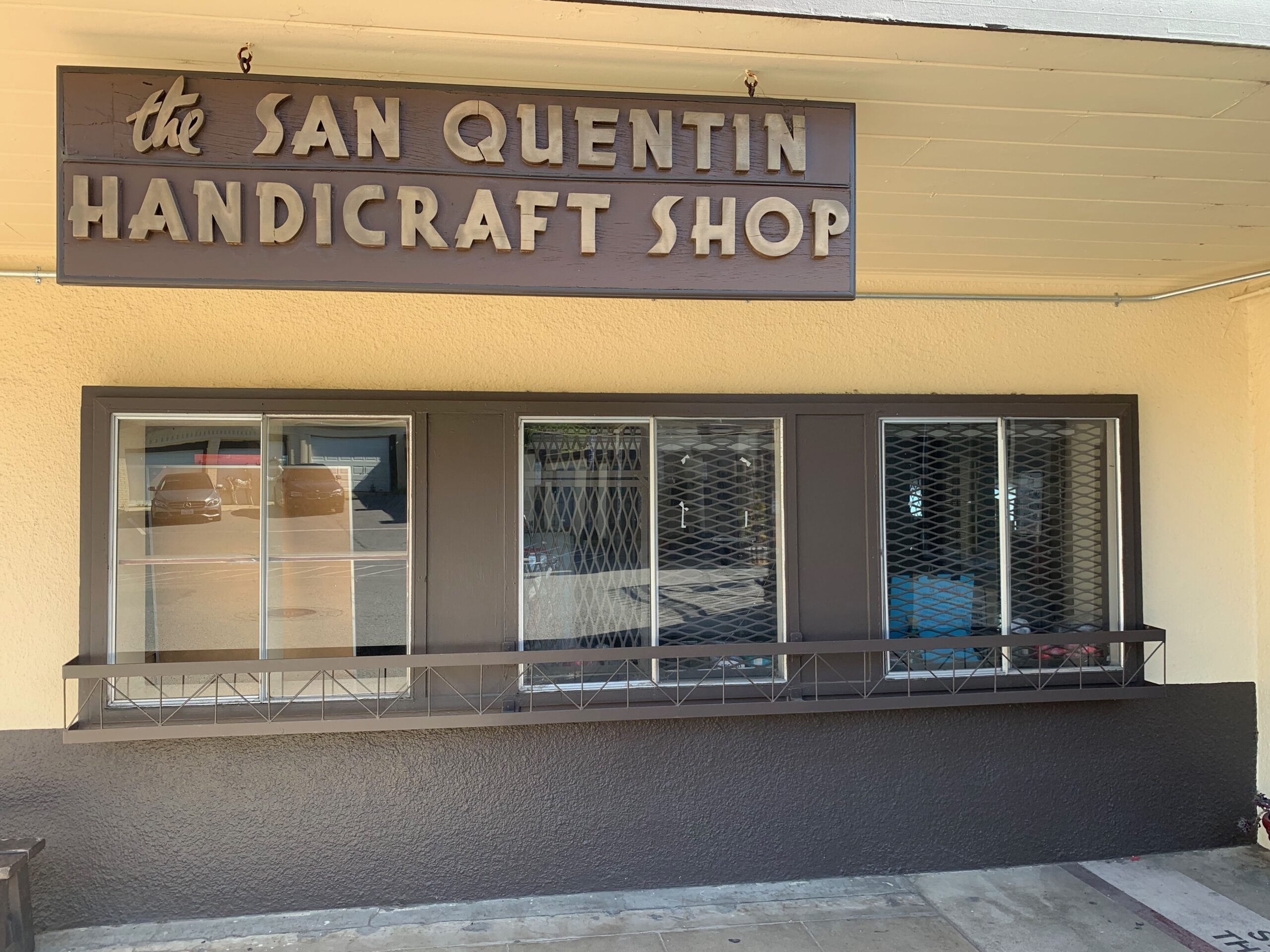
Officer Mahmood is taciturn but not unfriendly. I think he harbours a justifiable caution to this unknown bloke who’s just rocked up on a motorbike and is asking all sorts of questions. There’s a little post office by the entrance gate. It styles itself as “US Post Office, San Quentin California 94964”, which I find amusing as it seems like an inmate’s ID — Prisoner 94964, step forward! I think Officer Mahmood maybe has a humour deficit as his face stays when I suggest this.
“You can get stuff over there,” he says, pointing to the building to the left of the gate. A sign on the front says San Quentin Handicraft Shop but its closed and there’s nothing inside, as far as I can see through the dirty windows.
I can take pictures of it, of the post office, of the entrance gates and the avenue down to the prison but not — no sir! — of Officer Mahmood. He did tell me, however, that the jail was a level 2, which means it’s a bit less than top security.
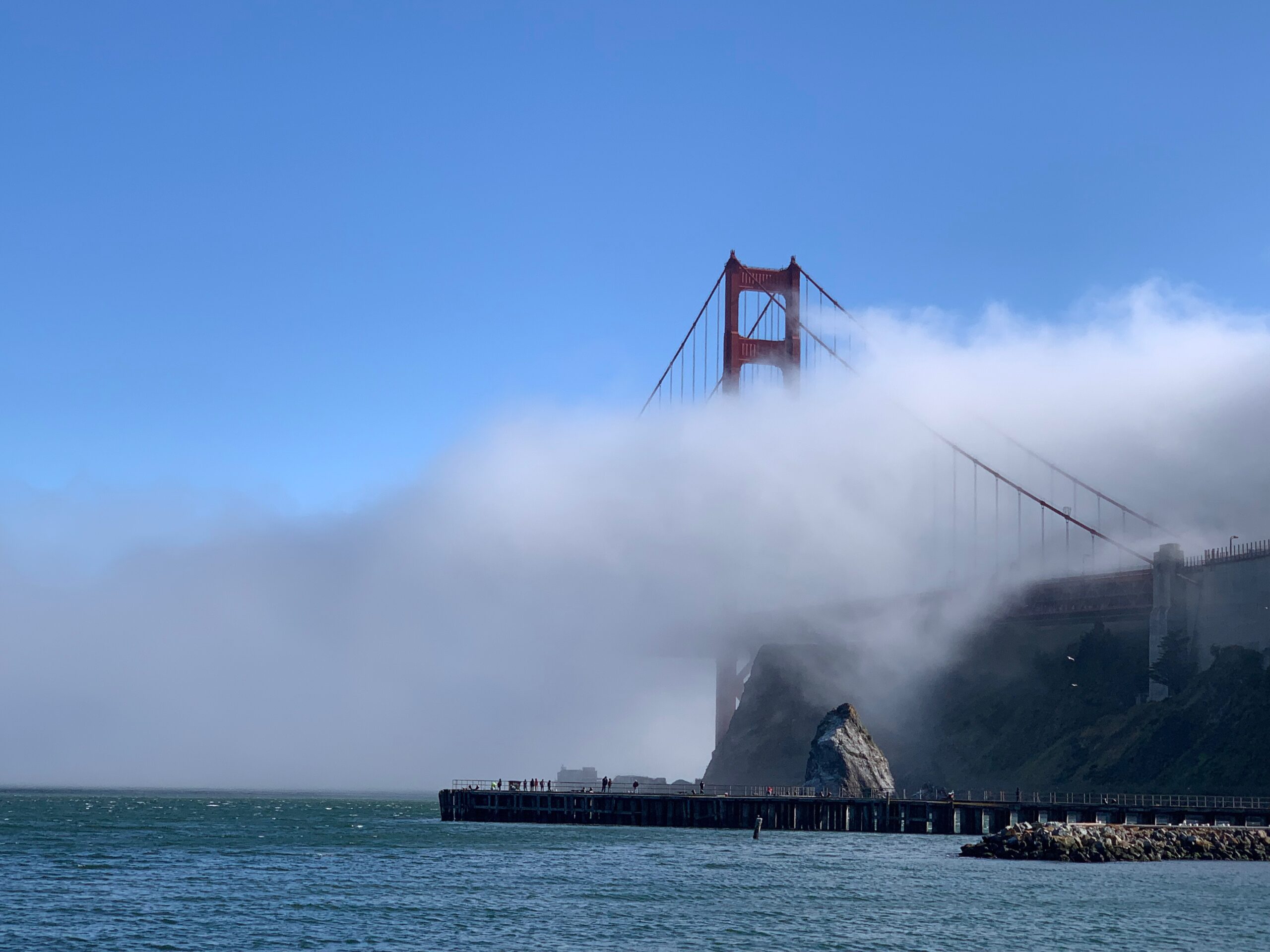
The Golden Gate Bridge is shrouded in San Francisco’s famous sea fog when I eventually approach it — first by descending to Fort Baker, the former army camp on the northern shore at the foot of the bridge which is now mainly a Coast Guard base, a few homes and a hotel, and then, still not having crossed over, from above, up in the Marin Headlands where one gets a panoramic view of the bridge and the city beyond. The fog snuck in like a cat, blanketing the sea and the bridge in a moving, frothy misty-grey. It changes shape very few seconds and when it is there, so huge is the bridge itself that it has an effect on the behaviour of the fog, forcing it up as it pours into the bay, before falling down again. And as it envelopes the area, fog horns on the bridge, three mounted on the middle pier and at two on the south tower pier, blow their moody, ghostly warning to shipping. I loved the sound of it, and the look of it, and got some half decent photos, I think.
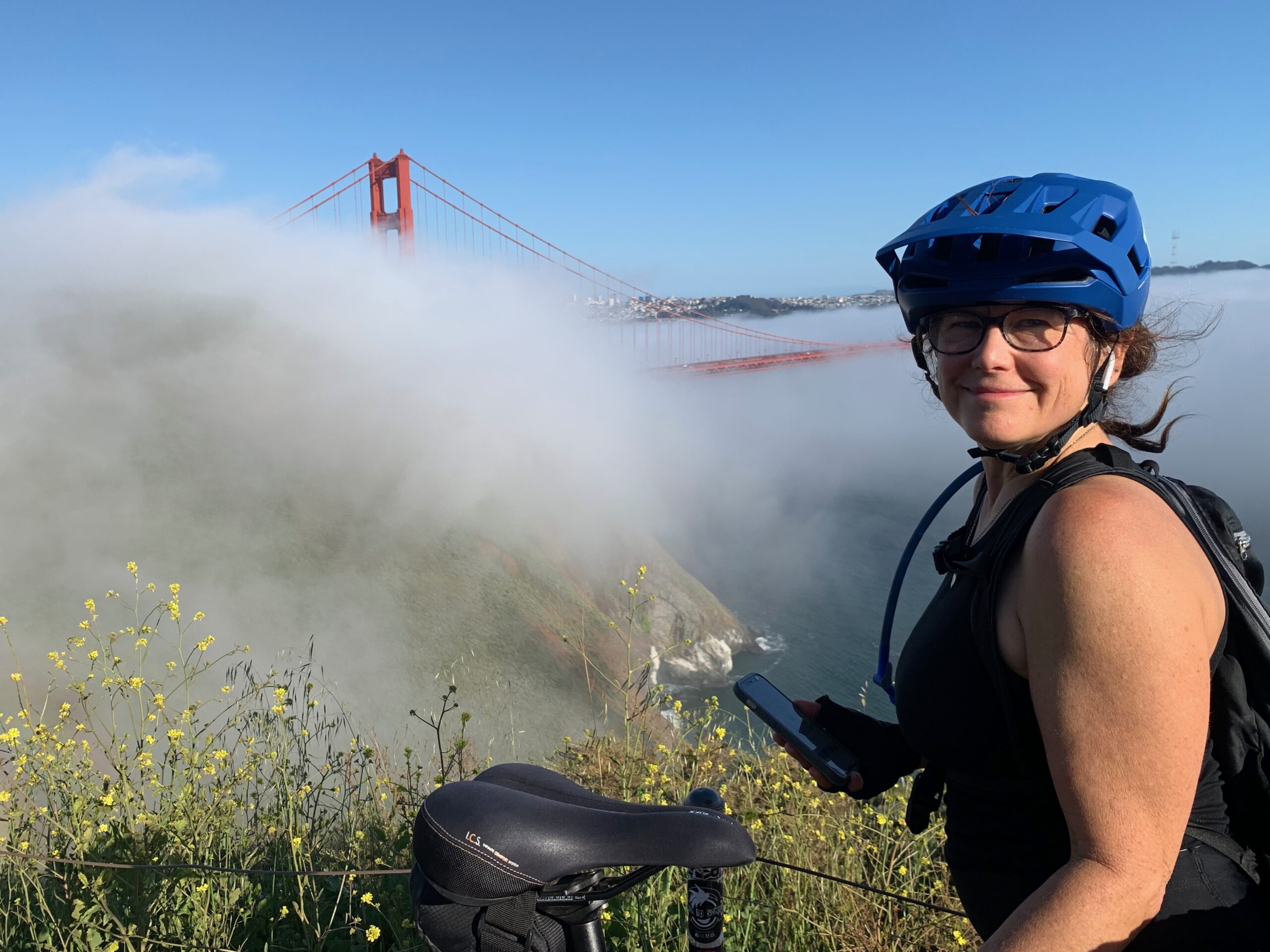
“You know he has a name,” said Rebecca, a Jewish cyclist (she told me she was Jewish within seconds of us getting chatting at one of the Marin viewing points).
“Eh, I didn’t actually,” I replied. “What is it?”
“Karl with a K,” she said.
“Why Karl,” I asked.
“Because that’s his name,” she said, a totally brilliant answer to which there is no adequate response.
Crossing the bridge was uneventful — largely because Karl had stolen the view. But up close, the orange towers from which the cables holding up the suspended roadway flow, still appear like giants in the mist. I rode across and took a right into the Presidio area, finding myself eventually in a small district named Sea Cliff. It’s a warren of narrow roads and cul-de-sacs lined with some really lovely looking homes, some of them backing onto cliffs above Baker Beach and China Beach and with views over the Pacific. I got off the bike at the end of one of the cul-de-sacs where there were steps down onto the beach.
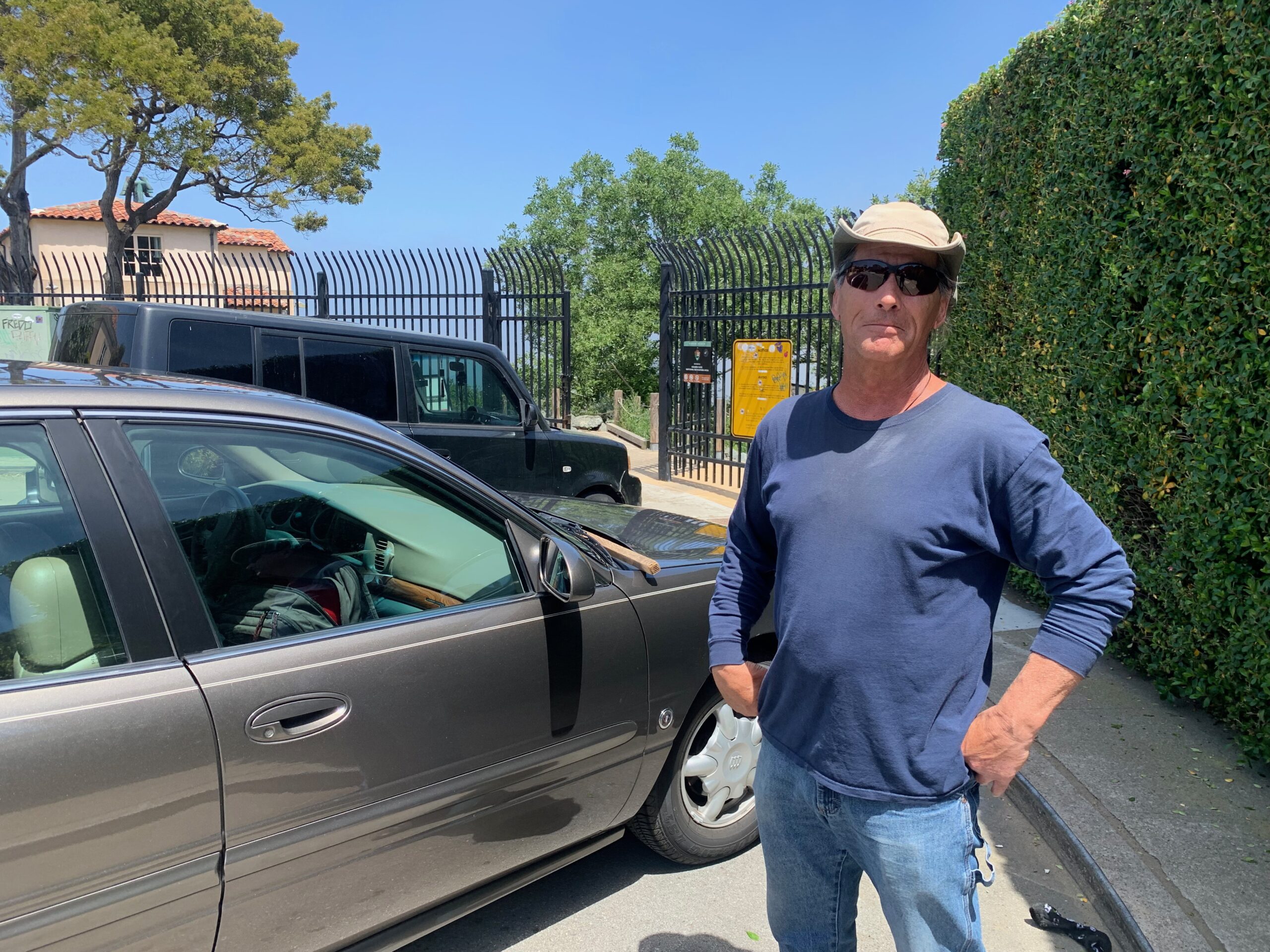
Standing there beside his car, a big long think like an old Jag that might have been a Buick, was Dave. He was wearing shades and a bush hat with the sides pinned up that reminded me of Denis Hopper in Easy Rider. He used to be a Marine (Dave, that is) but was now in construction.
Some of these houses — and they weren’t mansions, just very well maintained two storey semi-ds in a great location — must be worth three or four million, I ventured. “More like 20,” said Dave. He went on to tell me that Robin Williams’ mother lived up the road (pointing towards Seas Cliff Avenue) and Sharon Stone, “she had a place right there,” he said pointing. We’ve had Spielberg too, had ’em all, he said.
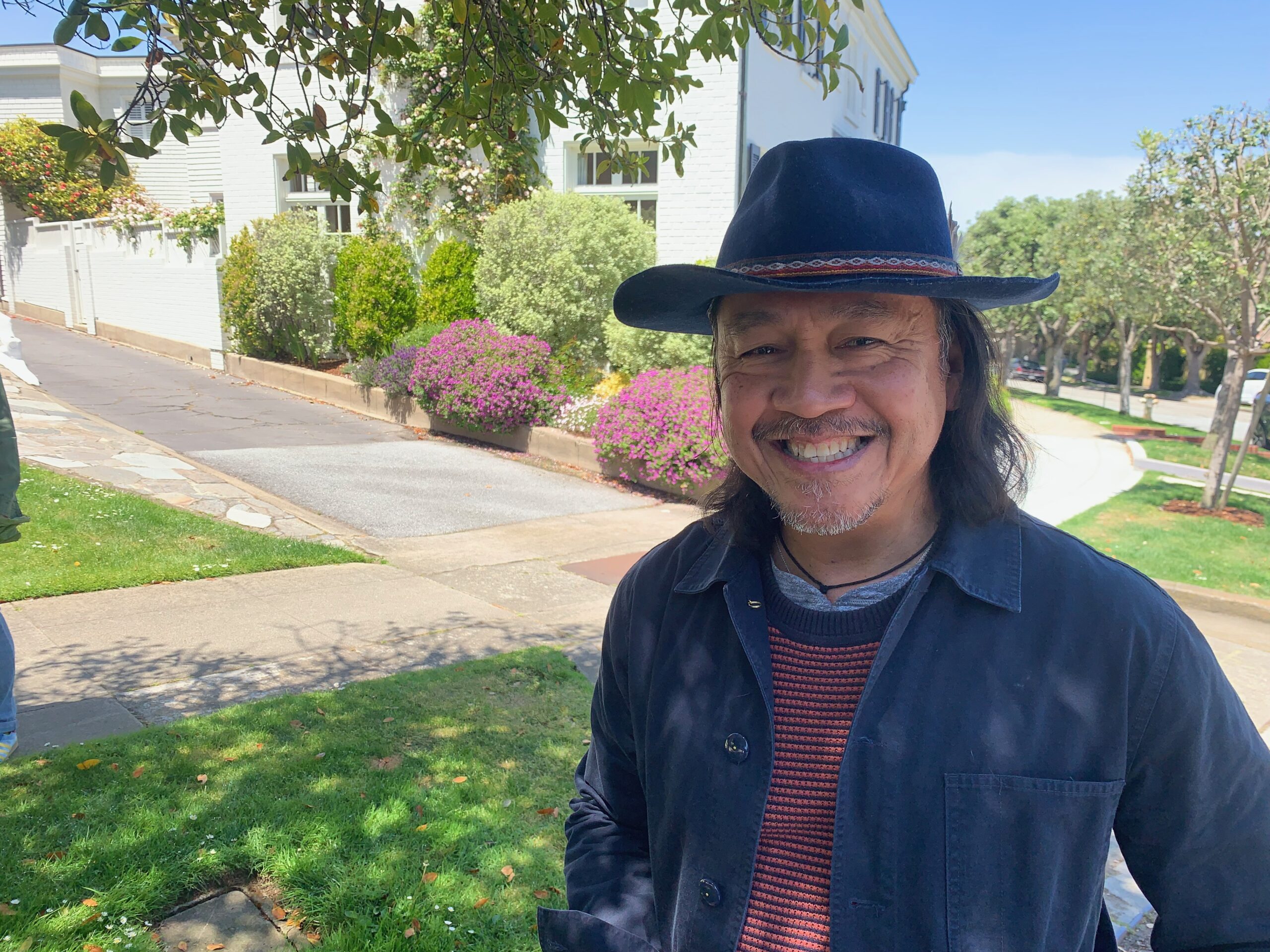
After having a look at the beach, I rode off again, up the avenue, stopping very soon after to take pictures of some of the houses. That was when I met Amanda from Islington in London, via her dog. We chatted — Amanda and me — and before long she said, “I’ve got to call Joe [her partner]. He’s going to want to meet you.” And that’s how I got to know Joe, another ex-Marine and now head of global workplace security at Pinterest, a Honda and Triumph Bonny rider, frequent visitor to Ireland and all round nice guy. And he wore a hat way, way cooler than Dave’s.
Next day, we met again in Sweetie’s, a small neighbourhood bar in North Beach, famous for its art exhibitions and jazz nights, and talked bikes, careers in the Marines, US politics, wives and pals, and the Wild Atlantic Way . . .
I spent much of the next couple of days writing and exploring and realising that, it’s not just areas like Pacific Heights, Russian Hill, Cow Hollow, Marina and other parts of the city close to downtown and Fisherman’s Wharf that have achingly beautiful buildings that are lived-in homes.
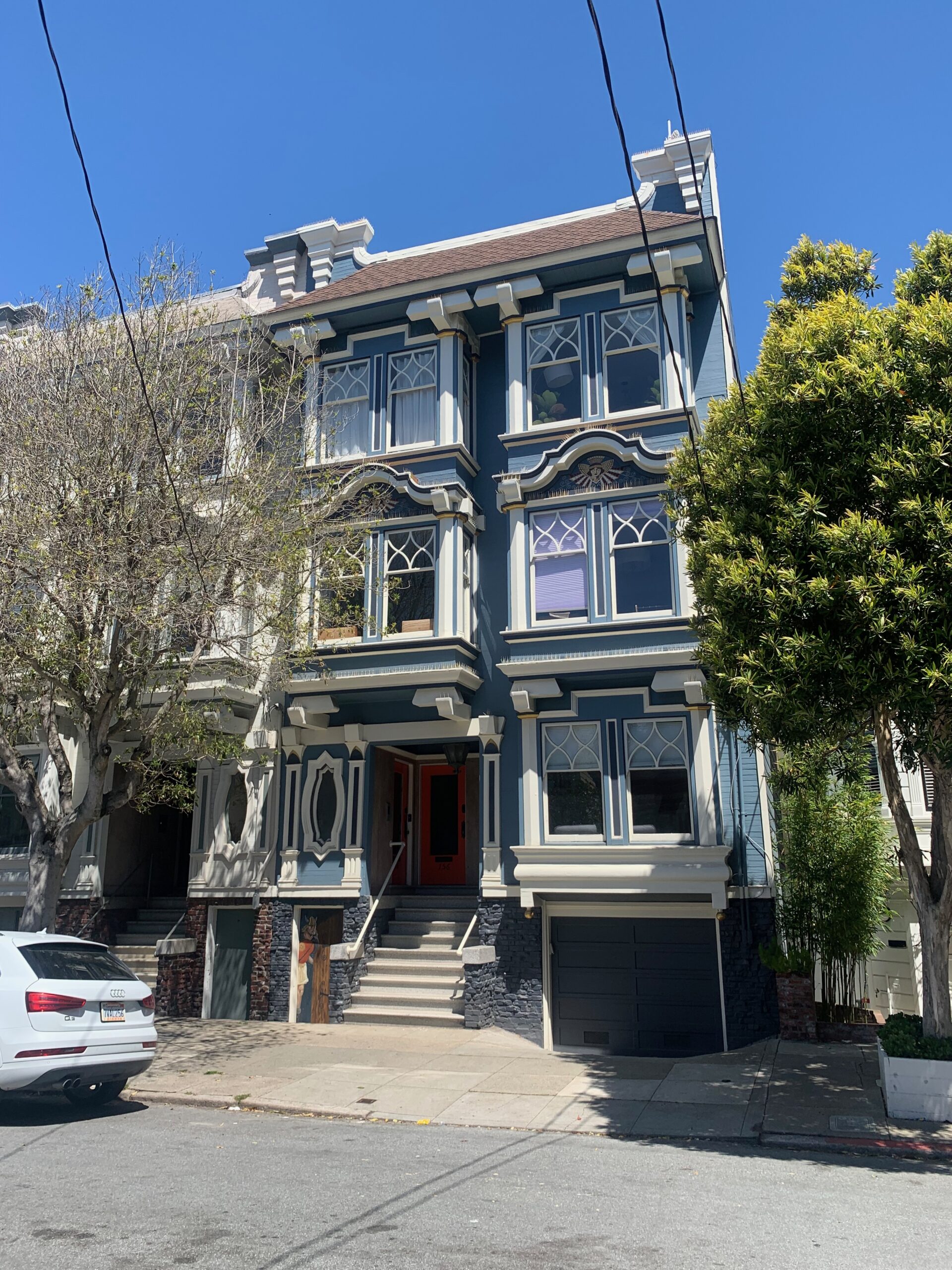
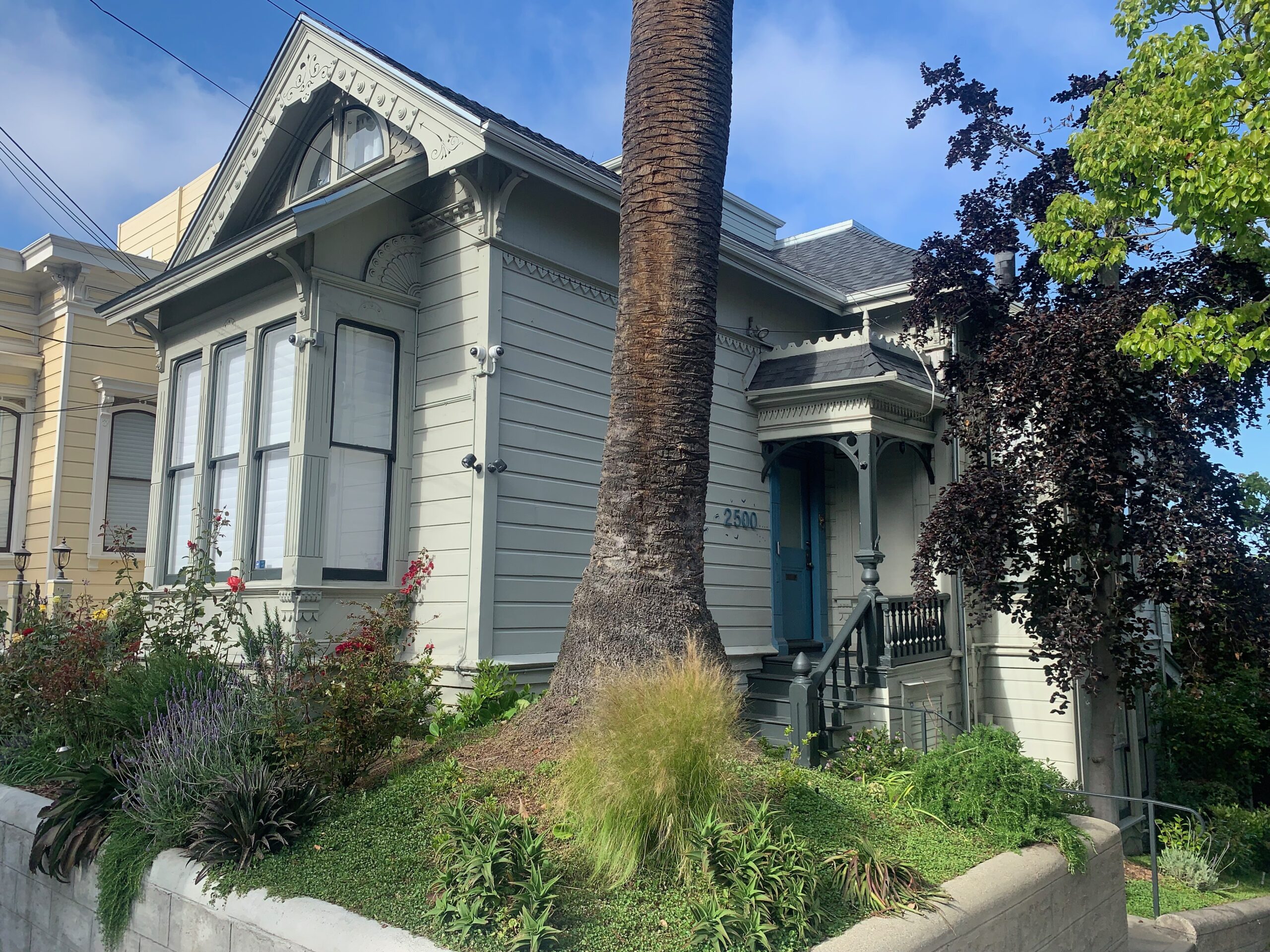
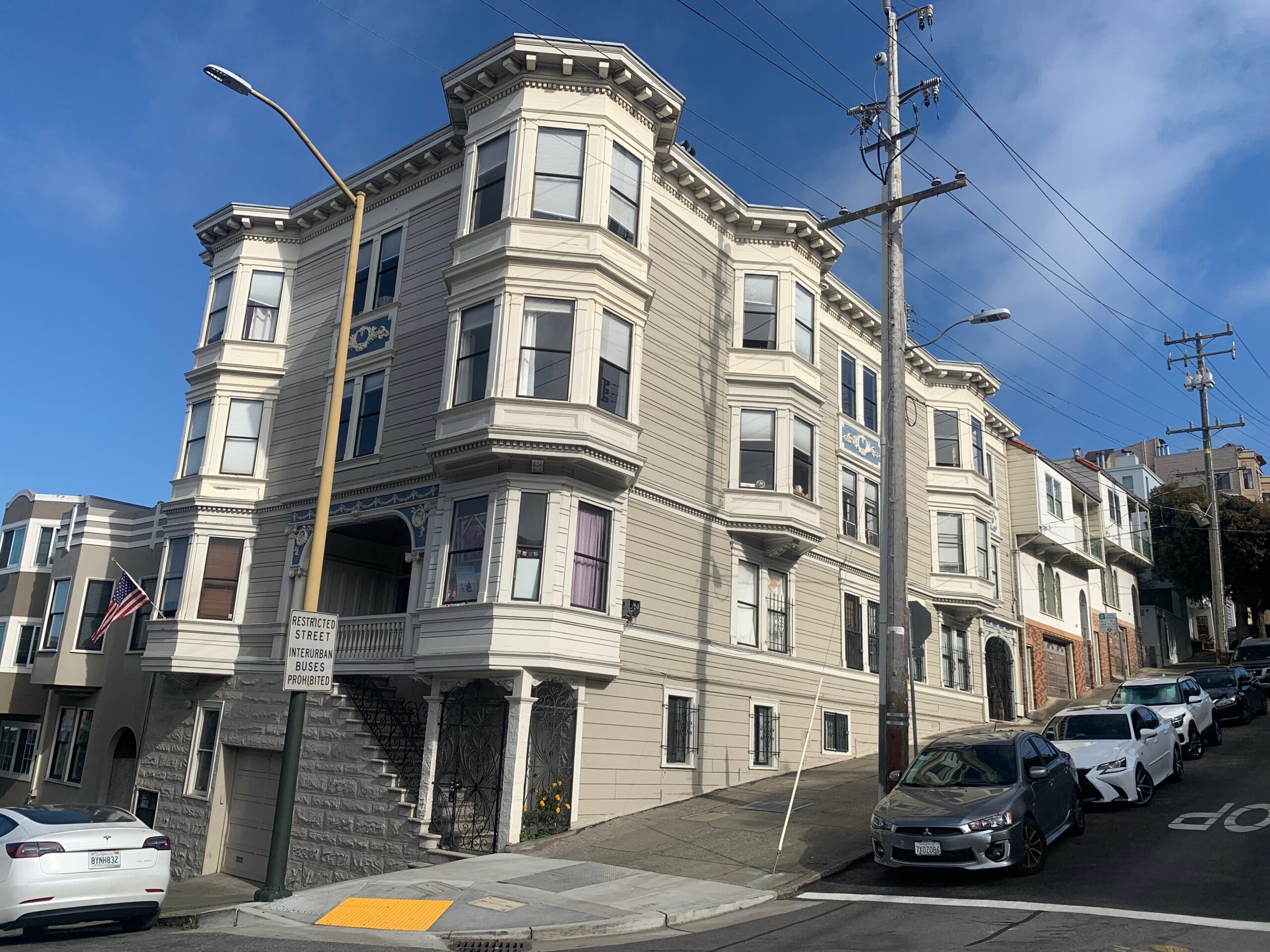
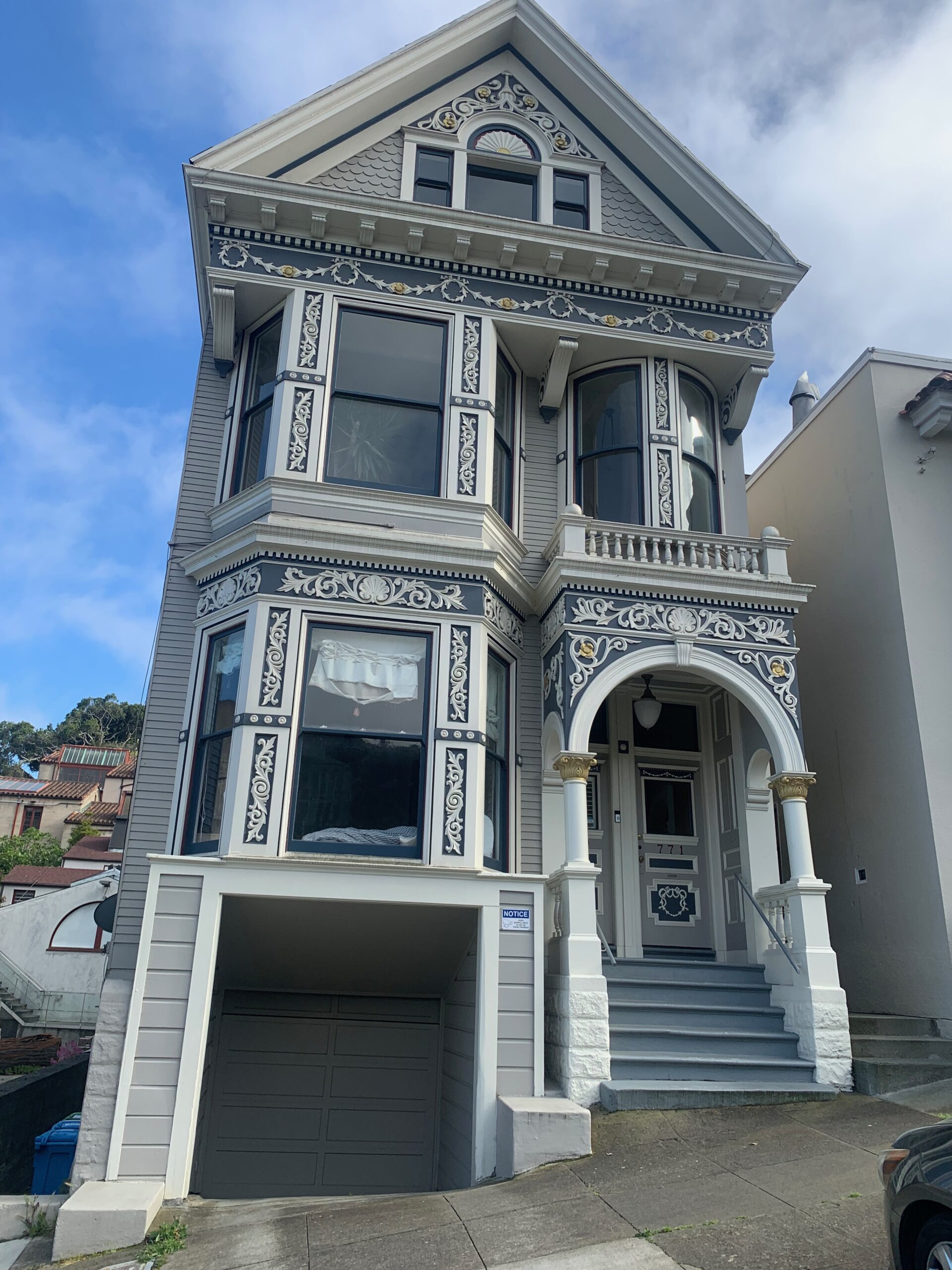
The delightful clapboard houses, almost always each a little different to its neighbour, and most of them treasured and well-maintained, are almost everywhere, certainly as far from the center as Haight-Ashbury (of 1968 summer of love fame). They make walking along every residential street a joy, every building a delight to behold. Within a day or two, I was heading back over the Golden Gate Bridge, this time going north, up 101 but then back onto the coast-hugging famed Highway 1 towards the redwoods. But San Francisco will live long and fondly in the memory.
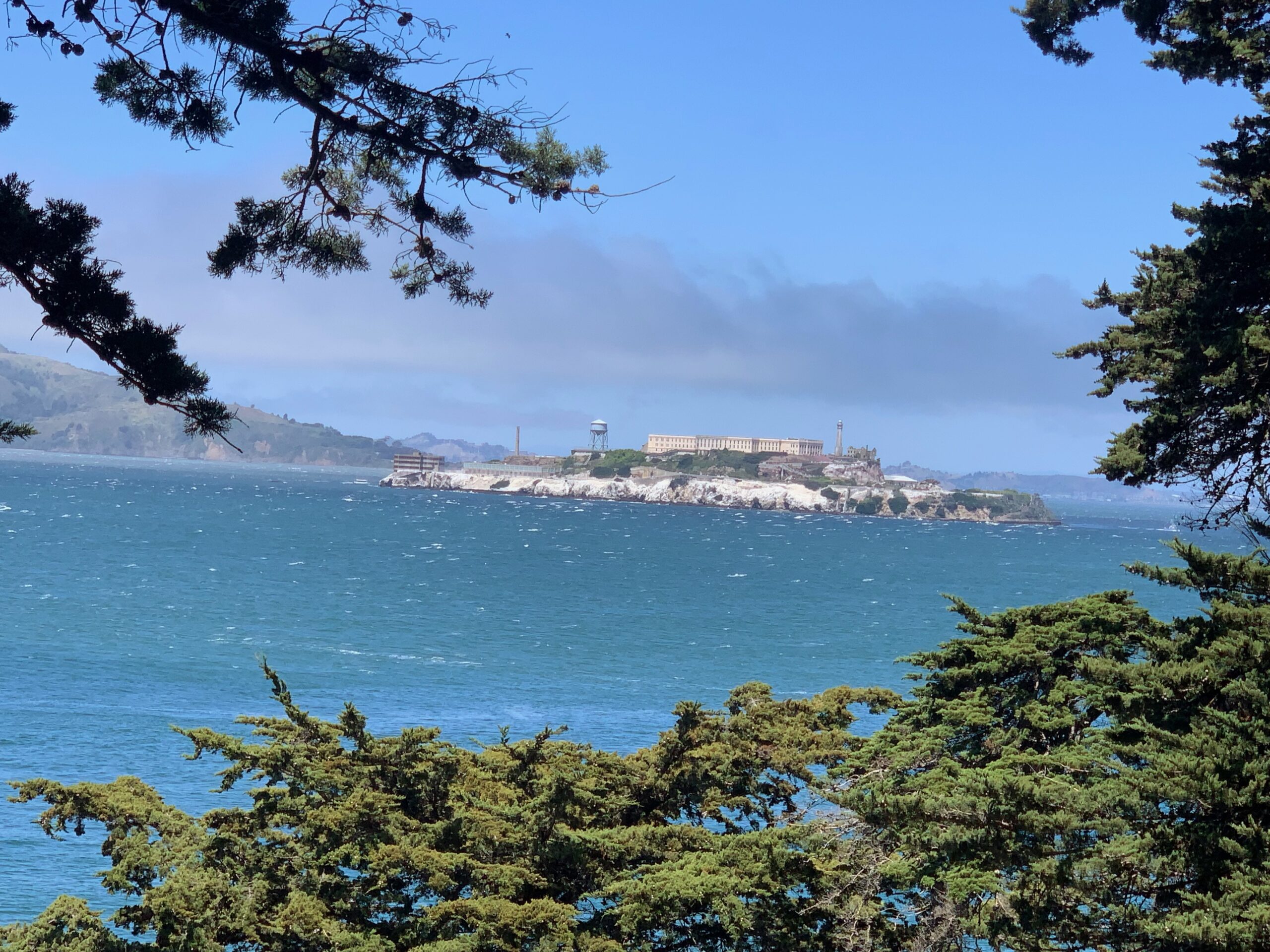
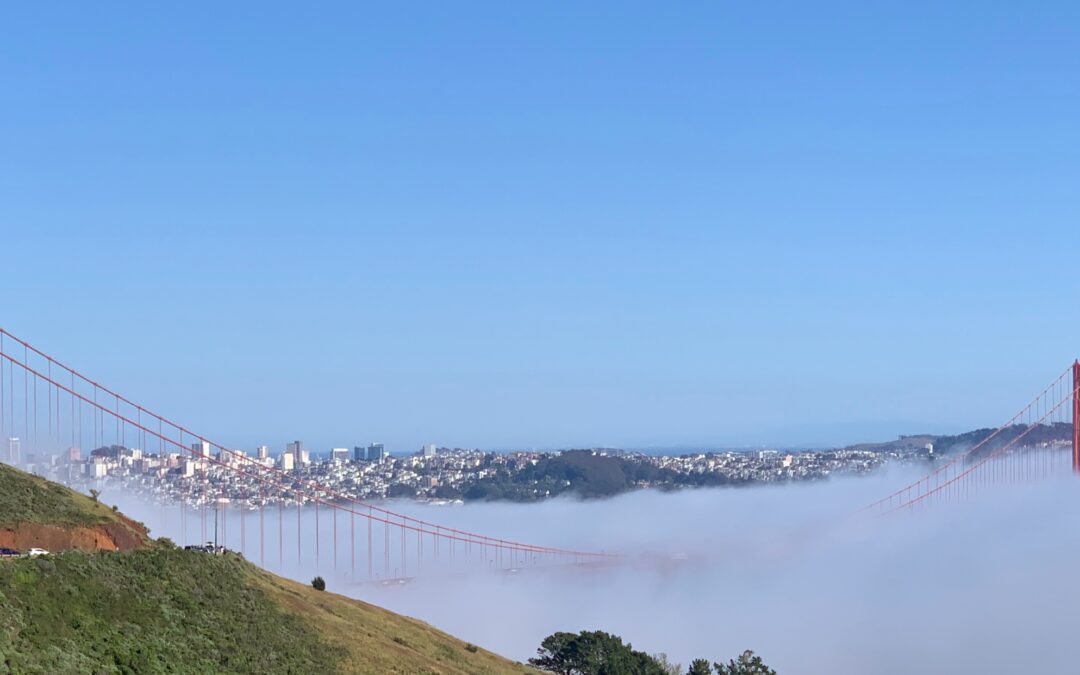
You have captured the whole essence of LA in a few exciting paragraphs and fed the hungry readers not to full capacity but to a craving for more lots more dear Peter!???????????
A great read Peter. All the best from Mayo. Stay safe.
Good piece, chum; and you didn’t meet a single gloomy person for a change. I salute you!
You nailed it – the San Fran piece. I’m a Dubliner, but lived in san Francisco for 35 years before moving to Palm Springs.
Even after that long, one still admires the houses, hills, people of the city.
Enjoying your blog.
A great piece Peter. You could get a job with the local tourist board!
I lived near Fisherman’s Wharf and worked on Beale Street from 1981 to 1982, met and married my wife there and went back with our kids to celebrate our 40th anniversary there last year. It’s a wonderful city and you have described it very well. There are a few more bars I could recommend to you before you return